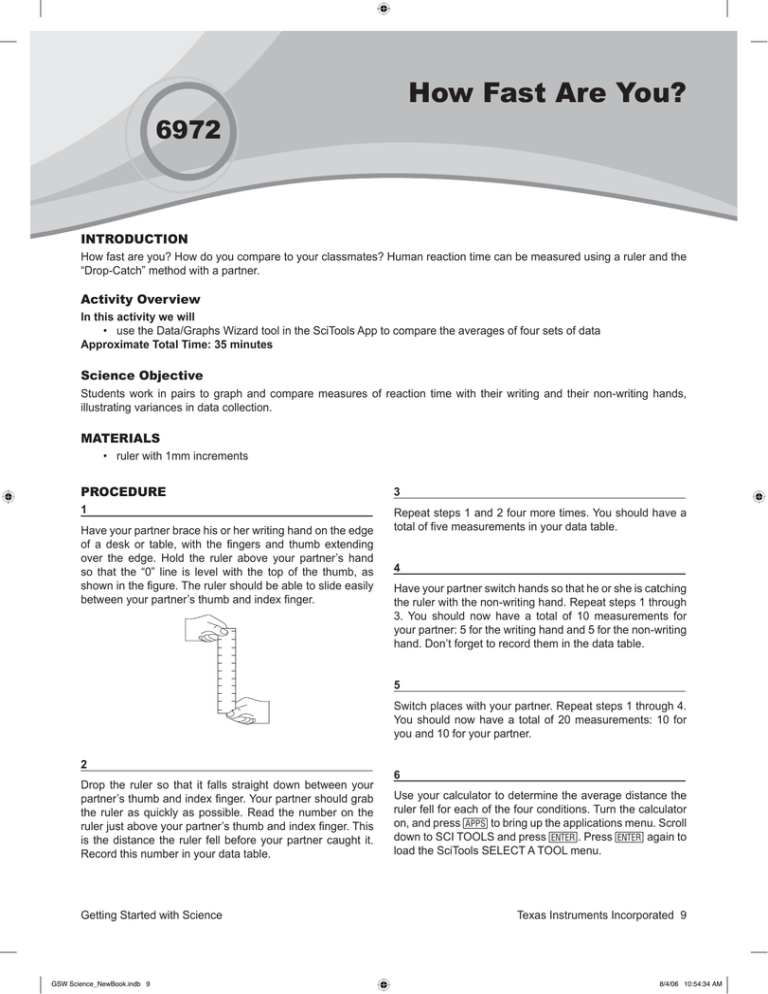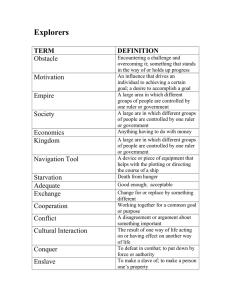Teacher Notes PDF - Education TI
advertisement

How Fast Are You? 6972 INTRODUCTION How fast are you? How do you compare to your classmates? Human reaction time can be measured using a ruler and the “Drop-Catch” method with a partner. Activity Overview In this activity we will • use the Data/Graphs Wizard tool in the SciTools App to compare the averages of four sets of data Approximate Total Time: 35 minutes Science Objective Students work in pairs to graph and compare measures of reaction time with their writing and their non-writing hands, illustrating variances in data collection. MATERIALS • ruler with 1mm increments PROCEDURE 3 1 Repeat steps 1 and 2 four more times. You should have a total of five measurements in your data table. Have your partner brace his or her writing hand on the edge of a desk or table, with the fingers and thumb extending over the edge. Hold the ruler above your partner’s hand so that the “0” line is level with the top of the thumb, as shown in the figure. The ruler should be able to slide easily between your partner’s thumb and index finger. 4 Have your partner switch hands so that he or she is catching the ruler with the non-writing hand. Repeat steps 1 through 3. You should now have a total of 10 measurements for your partner: 5 for the writing hand and 5 for the non-writing hand. Don’t forget to record them in the data table. 5 Switch places with your partner. Repeat steps 1 through 4. You should now have a total of 20 measurements: 10 for you and 10 for your partner. 2 Drop the ruler so that it falls straight down between your partner’s thumb and index finger. Your partner should grab the ruler as quickly as possible. Read the number on the ruler just above your partner’s thumb and index finger. This is the distance the ruler fell before your partner caught it. Record this number in your data table. Getting Started with Science GSW Science_NewBook.indb 9 6 Use your calculator to determine the average distance the ruler fell for each of the four conditions. Turn the calculator on, and press A to bring up the applications menu. Scroll down to SCI TOOLS and press e. Press e again to load the SciTools SELECT A TOOL menu. Texas Instruments Incorporated 9 8/4/06 10:54:34 AM How Fast Are You? 7 13 Press 3 to select the DATA/GRAPHS WIZARD. Press e to choose list L1 to analyze. This will tell the calculator to determine the average and other statistical information about the data in list L1. 8 Press ! to select DATA. This will open the list editor. Three lists—L1, L2, and L3—will be displayed on your screen. Use the arrow keys to select list L1. If there are already data in L1, use the up arrow to highlight L1, and press C, e. Enter the drop distances for the first condition (your partner’s writing hand) into list L1. To enter a drop distance, type in the distance and press e. The cursor should move down to the next line, where you can enter the next distance. 9 14 In your data table, record the average drop distance for the first condition. The average drop distance is shown on the screen, to the right of x = . For example, in this screen, the average drop distance is 9.18 cm. Use the arrow keys to move to list L2. Enter the drop distances for the second condition (your partner’s non-writing hand) into list L2. 10 Use the arrow keys to move to list L3. Enter the drop distances for the third condition (your writing hand) into list L3. 11 Use the arrow keys to move to list L4. Enter the drop distances for the fourth condition (your non-writing hand) into list L4. 15 Record the standard deviation (the average amount that your measurements vary from the average) for these data in your data table. The standard deviation is shown on the screen, next to ∑x =. 16 12 When you have entered all of your data, press `, M to return to the DATA/GRAPHS WIZARD menu. Press # to select STAT. Press `, M to return to the DATA/GRAPHS WIZARD menu. Press # to select STAT. Use the arrow keys to select list L2, and press e. Record the average drop distance and the standard deviation for the second condition in your data table. 17 Repeat step 16 for lists L3 and L4. 10 Texas Instruments Incorporated GSW Science_NewBook.indb 10 Getting Started with Science 8/4/06 10:54:35 AM How Fast Are You? 18 When you have determined the average drop distance and standard deviations for all four conditions, press `, M to return to the DATA/GRAPHS WIZARD menu. Press `, M again to return to the SELECT A TOOL menu. Press ! to select EXIT to exit the SciTools App. DATA TABLE Your partner Writing hand Non-writing hand You Writing hand Non-writing hand Drop 1 distance Drop 2 distance Drop 3 distance Drop 4 distance Drop 5 distance Average drop distance Standard deviation RSD DATA ANALYSIS 1. 2. Which person had a faster reaction time with the writing hand, you or your partner? Was your average reaction time when you used your writing hand different from when you used your non-writing hand? Was your partner’s? 3. The standard deviation is a measure of how widely scattered your measurements are. It is often reported as a percentage called the relative standard deviation, or RSD. A large RSD indicates that your data are very variable. To calculate the RSD, divide the standard deviation by the average and multiply by 100: RSD 4. standard deviation r 100 average Calculate the RSD for each of the four conditions. Which condition had the most-variable data (the highest RSD)? Which condition had the least-variable data (the lowest RSD)? Compare your results with other pairs of students. What can you conclude from the class results? Getting Started with Science GSW Science_NewBook.indb 11 Texas Instruments Incorporated 11 8/4/06 10:54:36 AM
